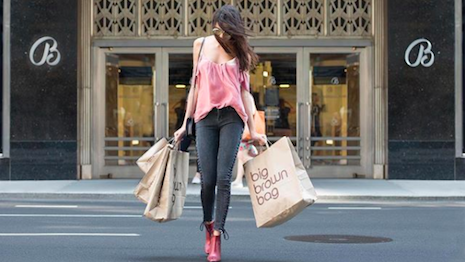- About
- Subscribe Now
- New York,
May 20, 2019

 Millennials are driving retail insights. Image credit: Bloomingdale's
Millennials are driving retail insights. Image credit: Bloomingdale's
Consumers have a long history of flaunting specific brands to showcase their status, but new research shows millennials are more interested in showing off sport clothing brands than luxury names.
According to a new report from First Insight, 23 percent of millennials in the United States flex sports brands. The term flex refers to wearing specific brands to show personal association with brand, but only 19 percent of U.S. millennials refer to doing this with heritage brands and 17 percent for luxury brands.
First Insight looked at responses from 1,000-targeted U.S. consumers, as well as a similar study with 565 U.K. consumers. The studies took place in February and April this year, respectively.
“Millennials continue to be the dominant force in retail both in the U.S. and the United Kingdom, as their shopping habits can be a deciding factor in what makes or breaks the success and longevity of retail models,” said Greg Petro, CEO of First Insight.
Millennials and retail
The study revealed that millennials are most likely to “flex” brands and are also the biggest spenders for both online and offline.
Seventy-four percent of American millennials are likely to spend $50 or more when entering a store as well as online. This is slightly more than 71 percent of their Generation X counterparts and 65 percent of baby boomers.
 Millennials are critical to luxury brands' future. Image credit: “Meet the HENRYs: The Millennials that Matter Most for Luxury Brands” (Paramount Book Publishing, 2019)
Millennials are critical to luxury brands' future. Image credit: “Meet the HENRYs: The Millennials that Matter Most for Luxury Brands” (Paramount Book Publishing, 2019)
In the U.K., 58 percent of millennials say the same, compared to 42 percent of Gen X and 38 percent of baby boomers.
Millennials are also slightly more likely to add extra items to their carts online and in-stores, with 87 percent in the U.S. saying they sometimes or always do. Eighty-six percent of Gen X consumers say the same, as well as 78 percent of baby boomers.
The research shows that impulse shopping is still going strong and remains an important part of retail. But retail continues to be disrupted and subscriptions boxes are a significant part of this disruption.
Millennials’ interest in subscription services is continuing to grow.
 Affluent millennials are most interested in connection. Image credit: Jimmy Choo
Affluent millennials are most interested in connection. Image credit: Jimmy Choo
A total of 25 percent of all U.S. consumers in the study currently pay for a subscription service, but this percentage jumps to 31 percent when looking just at millennials. For Gen X, this number drops to 21 percent, and it is even lower for baby boomers at 8 percent.
Thirty-eight percent of millennials in the U.S. plan to subscribe in the next six months, but only 18 percent in the U.K. plan to do so.
Additional insight
While baby boomers and Gen Z consumers are pulling back on their online fashion spending, millennials are making more apparel purchases via ecommerce.
According to a new report from Criteo, millennials spent 4 percent more on clothing and accessories online last year, showing a greater preference for fashion ecommerce than their younger Gen Z counterparts. As these generations become a greater part of the luxury business, luxury brands need to be ready to meet their disparate multichannel shopping habits (see story).
Millennials also expect brands to be more value-conscious, though not necessarily in the way marketers have come to anticipate.
A report from Morning Consult finds that honesty, quality and customer service are among the most important brand traits for millennials to drive loyalty. While much has been made of the impact of brands' political values on younger shoppers, this survey shows some experts may have been overemphasizing the importance of these positions on millennials' decision making (see story).
“Our study found that where Millennials shop, how they shop and when they wear the brands they love are in close alignment with how they define themselves," Mr. Petro said. "Retailers must be able to connect with this generation through the right shopping experiences and unique products if they want to capture the attention of this important generation of shoppers.”
Share your thoughts. Click here